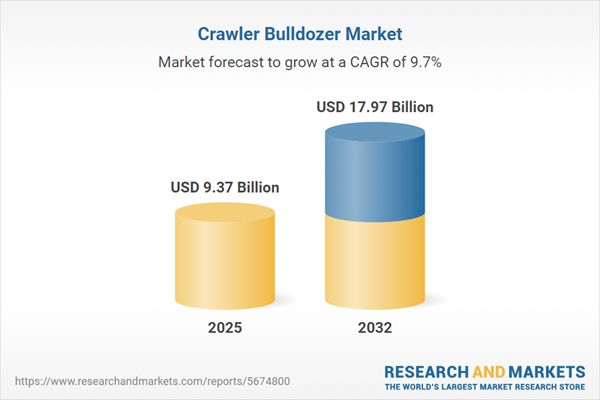Speak directly to the analyst to clarify any post sales queries you may have.
The crawler bulldozer market is undergoing rapid adaptation as organizations address evolving infrastructure challenges and regulatory pressures. Senior executives are reassessing operational strategies to remain agile and competitive while deploying advanced technologies to support project execution.
Crawler Bulldozer Market Snapshot and Outlook
In 2024, the crawler bulldozer market reached USD 8.55 billion with projections indicating growth to USD 9.37 billion by 2025 and further expansion to USD 17.97 billion by 2032, reflecting a stable 9.71% CAGR. This sustained momentum is driven by increased investment in global infrastructure and accelerated digital transformation initiatives. Organizations are focusing on sustainability, efficiency, and compliance to meet evolving regulatory requirements. As end users pivot toward reliable equipment and data-driven operations, the market anticipates further advances in both technology integration and operational models aligned to new infrastructure demands.
Scope & Segmentation in the Crawler Bulldozer Market
This report provides structured segmentation designed for decision-makers overseeing procurement, operational strategy, and investment alignment. Each core segment enhances visibility into demand, helping leaders map strategies tailored to their business context.
- Applications: Includes agriculture, construction, forestry, mining, and military, allowing precise evaluation of demand concentration and asset deployment across sectors.
- Operating Weight: Classifies equipment as heavy, medium, or light, streamlining the match of machinery to specific project types and site requirements.
- Engine Power: Divides machines into below 100 HP, 100–200 HP, and above 200 HP categories, supporting optimal equipment selection according to project complexity and scale.
- End Users: Spans contractors, government agencies, military, and private organizations, highlighting unique procurement cycles and operational needs.
- Blade Types: Encompasses angle, straight, and universal blades, providing detail for selection relevant to diverse earthmoving and grading activities.
- Transmission Types: Differentiates electric, hydrostatic, and mechanical systems, which helps companies align powertrain and control architecture with technical preferences.
- Track Designs: Identifies rubber and steel track options, informing adaptability to varied terrain, climate, and project region.
- Geographical Coverage: Covers Americas, Europe, Middle East & Africa, and Asia-Pacific, drawing out regulatory, supply chain, and infrastructure drivers per region to guide multinational planning.
- Key Company Profiles: Showcases major suppliers such as Caterpillar Inc., Komatsu Ltd., Shandong Shantui, Xuzhou Construction Machinery, SANY Heavy Industry, Deere & Company, Volvo Construction Equipment, Liebherr, CNH Industrial N.V., and Doosan Infracore. These profiles enable buyers to make informed, fact-based comparisons for procurement or partnership decisions.
Crawler Bulldozer Market: Key Takeaways for Senior Decision-Makers
- Strengthening relationships with suppliers and focusing on efficient capital allocation support resilience and continuity as regulatory demands and infrastructure priorities evolve.
- Integration of smart hydraulics, telematics, and onboard artificial intelligence allows real-time machine monitoring, which supports predictive maintenance strategies and minimizes operational interruptions.
- Implementation of remote operation and semi-autonomous capabilities mitigates workforce shortages, improves operational safety, and delivers reliable performance on expansive projects.
- Adoption of electrified and hybrid powertrains aligns company fleets with sustainability goals and compliance requirements, ensuring readiness for future standards and environmental expectations.
- Leveraging rental and leasing models enhances asset flexibility, allowing enterprises to efficiently adjust to dynamic project flows and fluctuating capital budgets.
Tariff Impact and Strategic Responses
Recent US tariff policy changes affecting steel, engine components, and key inputs have prompted manufacturers to diversify supply chains and pursue regional joint ventures, particularly where local assembly may provide relief from tariff effects. As a result, industry participants are revising sourcing and maintenance practices, focusing on adaptable procurement models such as leasing to counter supply chain volatility. These shifts help synchronize financial planning with market uncertainties and sustain reliable equipment access amid changing global trade conditions.
Methodology & Data Sources
This assessment is based on structured interviews with business, technical, and procurement leaders, complemented by review of industry reports, regulatory filings, logistics data, and trade analytics. Analytical rigor is maintained using PESTEL and Porter’s Five Forces frameworks to evaluate sector influences and risk factors.
Why This Report Matters for Your Operation
- Offers actionable intelligence for strengthening supply chain resilience and mitigating operational risks in dynamic business environments.
- Guides technology investments, ensuring compliance with regulatory frameworks and alignment with evolving sustainability mandates.
- Provides comprehensive segmentation and region-specific context that supports deployment planning, operational efficiency, and strategic asset management.
Conclusion
This market report assists senior executives in navigating sector changes, leveraging new technologies, and driving sustainable growth. It provides a foundation for resilient, forward-looking crawler bulldozer operations.
Additional Product Information:
- Purchase of this report includes 1 year online access with quarterly updates.
- This report can be updated on request. Please contact our Customer Experience team using the Ask a Question widget on our website.
Table of Contents
3. Executive Summary
4. Market Overview
7. Cumulative Impact of Artificial Intelligence 2025
List of Figures
Samples

LOADING...
Companies Mentioned
The key companies profiled in this Crawler Bulldozer market report include:- Caterpillar Inc.
- Komatsu Ltd.
- Shandong Shantui Construction Machinery Co., Ltd.
- Xuzhou Construction Machinery Group Co., Ltd.
- SANY Heavy Industry Co., Ltd.
- Deere & Company
- Volvo Construction Equipment AB
- Liebherr International AG
- CNH Industrial N.V.
- Doosan Infracore Co., Ltd.
Table Information
| Report Attribute | Details |
|---|---|
| No. of Pages | 189 |
| Published | October 2025 |
| Forecast Period | 2025 - 2032 |
| Estimated Market Value ( USD | $ 9.37 Billion |
| Forecasted Market Value ( USD | $ 17.97 Billion |
| Compound Annual Growth Rate | 9.7% |
| Regions Covered | Global |
| No. of Companies Mentioned | 11 |









